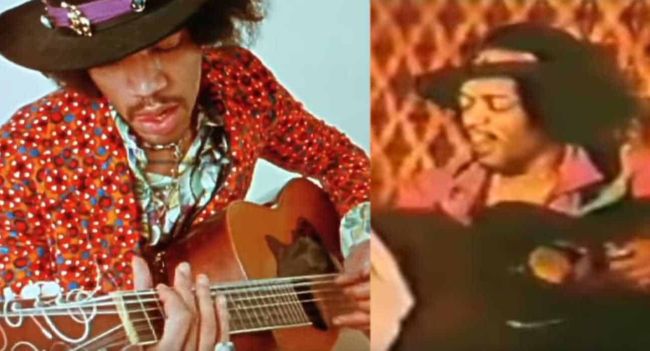So, did Jimi Hendrix play the acoustic much? Well yes! Recordings of Hendrix playing acoustic may be few and far between, and none are finished recordings, but that’s another matter. Some might wonder if there’s any point to listening to acoustic Hendrix? Isn’t it diluted Hendrix? As always, Jimi’s guitar skill speaks for itself. Just listen!
The two known film clips of acoustic Hendrix were edited together by musician Gaurav Krishnan of Bombeats Music. Interestingly, both are from the time Hendrix spent formulating his sound in London in the late 1960s. The first – a Zemantis 12-String take of Hear My Train a-Comin’ – was filmed at photographer Bruce Fleming’s London studio, 19 December 1967, by Peter Neal. It featured in Neal’s short film Experience aka See My Music Talking (1968) and was included in the doc Jimi Hendrix (1973).
The second clip was most likely filmed in the Mayfair flat Jimi shared with his girlfriend Kathy Etchingham. According to Etchingham, the Epiphone model FT79 guitar, seen in the Hound Dog clip, was a favourite. Jimi tended to play it in the flat on account of not wanting to be evicted for noise. He also practiced on an unplugged electric. For those who are wondering, there are electric versions of both tracks. Hendrix’s electric version of Hound Dog, recorded at the BBC, is the less well known:
The soundtrack of the footage of the acoustic Hear My Train A Comin’ was officially released on the album Blues (1994). The electric version can be heard on the Both Sides of The Sky compilation (2018). Both versions are firmly in the Hendrix canon.
The bedroom take on Hound Dog is interesting in a number of ways. First, it offers a glimpse into the period before Hendrix became a superstar. Jimi is relaxed, jamming in his flat for friends. It looks like it’s Kathy Etchingham seated immediately in front of him, with her hand hand on Jimi’s knee. Second, Hendrix’s take on Hound Dog owes more to Big Mama Thornton (as released in 1952) than the subsequent Elvis Presley recording. Third, Hendrix doesn’t know the words that well, which may explain the illuminating ad lib at the end. Hendrix sings “Two old maids lying in bed, one rolled over to the other and said …” prompting laughter.
It is doubtful that Hendrix’s London friend’s picked up that he was singing the first half of a U.S. Army Airborne running cadence. Cadences are songs/chants used to keep time. One of the more famous US military cadences is for marching: “These Boots are Made for Walking …”. The second couplet of the running cadence, which Hendrix omits, is “I want to be an Airborne Ranger, live a life of sex and danger.”
One cannot conclude a piece on acoustic Jimi Hendrix without mentioning Black Gold, the song cycle (16 songs) that Hendrix recorded as acoustic demos in 1970. The recording was presumed to be lost until 1992, when Hendrix biographer Tony Brown discovered that Mitch Mitchell had a copy. Hendrix gave a tape copy to his drummer, so that Mitchell could help work the songs up, shortly before Hendrix’s death. The tape is now owned by Hendrix’s half-sister Janie. For many Hendrix fans, Black Gold is the most important of Jimi Hendrix’s unreleased material.
As a young guitar player, perhaps no one inspired me as much as Jimi Hendrix, though I never dreamed I’d attain even a fraction of his skill. But what attracted me to him was his near-total lack of formality—he didn’t read music, wasn’t trained in any classical sense, played an upside-down right-handed guitar as a lefty, and fully engaged his head and heart in every note, never pausing for an instant (so it seemed) to second-guess whether it was the right one. I knew his raw emotive playing was firmly rooted in the Delta blues, but it wasn’t until later in my musical journey that I discovered his return to more traditional form after he disbanded The Experience and formed Band of Gypsys with Billy Cox and Buddy Miles. While most of the recordings he made with them didn’t see official release, they’ve appeared since his death in compilation after boxset after compilation, including one of the most beloved of Hendrix’s blues songs, “Hear My Train A Comin’.”
Originally titled “Get My Heart Back Together” when he played it at Woodstock in 1969, the song is pure roots, with lyrics that bespeak of both Hendrix’s loneliness and his playful dreams of greatness. (“I’m gonna buy this town / And put it all in my shoe.”) Several versions of the song float around on various posthumous releases—both live and as studio outtakes (including two different takes on the excellent 1994 Blues). But we have the rare treat, above, of seeing Hendrix play the song on a twelve-string acoustic guitar, Lead Belly’s instrument of choice. The footage comes from the 1973 documentary film Jimi Hendrix (which you can watch on Youtube for $1.99). Hendrix first plays the intro, seated alone in an all-white studio, playing folk-style with the fingers of his left hand. It is, of course, flawless, yet still he stops and asks the filmmakers for a redo. “I was scared to death,” he says, betraying the shyness and self-doubt that lurked beneath his mind-blowing ability and flamboyant persona. His playing is no less perfect when he picks up the tune again and plays it through.
Solo acoustic recordings of Hendrix—film and audio—are incredibly rare. If like me you’re a fan of Hendrix, acoustic blues, or both, this video will make you hunger for more Jimi unplugged. While Hendrix did more than anyone before him to turn guitar amps into instruments with his squalls of electric feedback and distorted wah-wah squeals, when you strip his playing down to basics, he’s still pretty much as good as it gets.
If you would like to sign up for Open Culture’s free email newsletter, please find it here.
